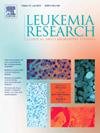Pre-transplant blinatumomab and/or inotuzumab ozogamicin therapy for relapsed/refractory acute lymphoblastic and B/myeloid mixed phenotype acute leukemia in adults
IF 2.1
4区 医学
Q3 HEMATOLOGY
引用次数: 0
Abstract
Real-world data on blinatumomab (BLI) and inotuzumab ozogamicin (INO) for relapsed or refractory B-acute lymphoblastic leukemia (RR-ALL) before hematopoietic stem cell transplantation (HCT) are limited. To compare the efficacy of salvage therapy with BLI and/or INO and conventional chemotherapy as a bridge to HCT, we retrospectively evaluated patients with RR-ALL who underwent first HCT at our institute between 2004 and 2023. Based on whether they had received salvage therapy with BLI and/or INO, 70 recipients were divided into a BLI/INO (n = 22) and a control group (n = 48). The complete remission (CR) rate before HCT was higher in the BLI/INO group than in the control group (77.3 % vs. 35.4 %, p = 0.002). Two years after the first HCT, the overall survival (OS) and disease-free survival (DFS) were significantly higher in the BLI/INO group than in the control group (OS, 63.0 % vs. 31.2 %, p = 0.022; DFS 49.6 % vs. 22.9 %, p = 0.049), with comparable cumulative incidence of relapse (CIR, 41.3 % vs. 47.9 %; p = 0.767) and lower tendency of non-relapse mortality (NRM, 9.1 % vs. 29.2 %; p = 0.057). Multivariate analysis revealed that non-CR status before HCT was the only factor associated with poor OS (hazard ratio [HR], 4.263; p < 0.001) and higher CIR (HR, 2.250; p = 0.048). In patients in CR at HCT, there was no difference in HCT outcomes at 2 years (OS, 82.4 % vs. 58.8 %; p = 0.324; DFS, 64.2 % vs. 47.1 %; p = 0.496; CIR, 24.1 % vs. 41.2 %; p = 0.375; NRM, 11.8 % vs. 11.8 %; p = 0.950). BLI and/or INO therapy for RR-ALL was associated with better survival after HCT, probably due to the higher CR rate.
移植前blinatumumab和/或inotuzumab ozogamicin治疗成人复发/难治性急性淋巴母细胞和B/髓混合表型急性白血病
在造血干细胞移植(HCT)前,blinatumomab (BLI)和inotuzumab ozogamicin (INO)治疗复发或难治性b急性淋巴细胞白血病(RR-ALL)的实际数据有限。为了比较BLI和/或INO救助治疗与常规化疗作为HCT桥梁的疗效,我们回顾性评估了2004年至2023年间在我们研究所接受首次HCT治疗的RR-ALL患者。根据是否接受过BLI和/或INO的补救性治疗,将70名患者分为BLI/INO组(n = 22)和对照组(n = 48)。BLI/INO组HCT前的完全缓解率(CR)高于对照组(77.3% % vs. 35.4% %,p = 0.002)。第一次HCT术后2年,BLI/INO组的总生存期(OS)和无病生存期(DFS)显著高于对照组(OS, 63.0 % vs. 31.2% %,p = 0.022;DFS 49.6 % vs. 22.9 %,p = 0.049),累积复发率可比(CIR, 41.3 % vs. 47.9 %;p = 0.767),非复发死亡率降低趋势(NRM, 9.1 % vs. 29.2 %; = 0.057页)。多因素分析显示,HCT前的非cr状态是与不良OS相关的唯一因素(风险比[HR], 4.263;p <; 0.001)和较高的CIR (HR, 2.250; = 0.048页)。在HCT的CR患者中,2年的HCT结果没有差异(OS, 82.4 % vs. 58.8 %;p = 0.324;DFS: 64.2 % vs. 47.1% %;p = 0.496;CIR, 24.1% % vs. 41.2 %;p = 0.375;NRM, 11.8 % vs. 11.8 %; = 0.950页)。BLI和/或INO治疗的RR-ALL与HCT后更好的生存率相关,可能是由于更高的CR率。
本文章由计算机程序翻译,如有差异,请以英文原文为准。
求助全文
约1分钟内获得全文
求助全文
来源期刊

Leukemia research
医学-血液学
CiteScore
4.00
自引率
3.70%
发文量
259
审稿时长
1 months
期刊介绍:
Leukemia Research an international journal which brings comprehensive and current information to all health care professionals involved in basic and applied clinical research in hematological malignancies. The editors encourage the submission of articles relevant to hematological malignancies. The Journal scope includes reporting studies of cellular and molecular biology, genetics, immunology, epidemiology, clinical evaluation, and therapy of these diseases.
 求助内容:
求助内容: 应助结果提醒方式:
应助结果提醒方式:


